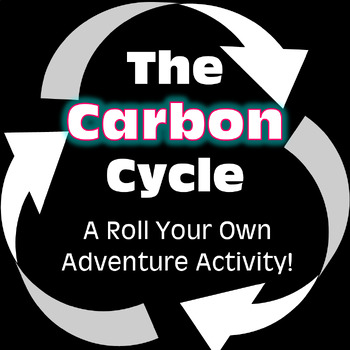Biogeochemical Cycles: The Carbon Cycle Dice Simulation Journey of a Carbon Atom
- PDF
- Easel Activity
What educators are saying
Also included in
- A bundle of activities for Ecology, Environmental Studies, and Earth Science.Please see individual files for additional details. ⭐Click here to follow my store & receive the latest updates.Original Artwork (©AwesomeScience). For Personal Use Only. Uneditable.Page count does not include Terms ofPrice $47.10Original Price $52.33Save $5.23
Description
A journey though the Global Carbon Cycle like you have never experienced before!
With a roll of the dice, students will travel around the classroom visiting nine of Earth’s carbon reservoirs: atmosphere, terrestrial plants, terrestrial animals, soil, rock, marine plants, marine animals, surface ocean, & deep ocean.
In the process, they will learn a whopping amount of information that will link to many other scientific units of study. Examples include: weather, circulation of air in the troposphere and stratosphere, carbonic acid, bicarbonate ions, calcium carbonate, photosynthesis and respiration, types of macromolecules (glucose, chitin, protein, lipids, DNA), decomposes, scavengers, detritivores and their role in ecosystems, consumers, herbivores, producers on land and in water, carnivores, bacteria, parts of the soil and soil erosion, combustion reaction, rock cycle and formation of sedimentary rock and limestone rock, hydrocarbons, tectonic plates, volcanic eruption, erosion and weathering, marine snow, downwelling and upwelling currents, dissolved carbon dioxide in cold and warm water, global ocean conveyor belt, and more.
Months of research went into compiling this 100% original resource that will serve not only as a fun get-out-of-your-seat activity but also, as an opportunity for students to get a wide-angle systems view of some of Earth’s processes.
Well worth a trip…or three…or eight…!
Crosscutting concepts: cause & effect, systems & system models, energy & matter, stability & change.
Included in this resource:
- Student record sheet (1-page);
- Teacher notes (1-page);
- Carbon reservoir posters, legal-sized, portrait orientation, two per reservoir taped together (18-pages);
- Carbon reservoir posters, legal sized, portrait orientation, one per reservoir (9-pages);
- TpT Easel version included for distance learning.
Equipment required for successful completion of this activity:
- one die per student (ideally) or, one die per carbon reservoir.
Click here to follow my store and receive the latest updates.
Original Artwork (©AwesomeScience). For Personal Use Only. Uneditable.
Page count does not include Terms of Use and links to supplementary activities.
Copyright ©AwesomeScience 2016 – The Present.
All Rights Reserved by Author.
By using this Resource you agree to the Terms as outlined in the Terms of Service. This Resource is for limited Personal Use only; not to be used, in part or in whole, for commercial purposes. Each Individual License is for use by one specific educator only. Additional licenses must be purchased for each additional educator. Except as permitted in Section 3 to deliver Resources electronically to Permitted Recipients, you may not post or otherwise make the Resource available on any website, application, shared drive or other sites or services.







